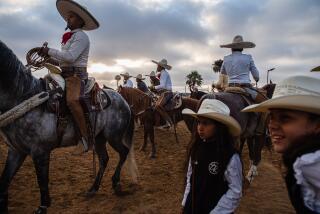In the stretch, ostriches are hellbent or leather : It’s no hat trick. In a plume of dust (and feathers), the brainless birds are racing back into Arizona’s heart.
- Share via
CHANDLER, Ariz. — The pre-race tension is thick enough to shovel, but that does not seem to bother 23-year-old Cody McGuire, a veteran ostrich jockey.
As three of the huge birds gawk above their stalls at the starting gate, McGuire coolly explains what it’s like to ride on the back of a powerful 400-pound creature that can bolt to 25 m.p.h. in two seconds flat.
“You can’t steer ‘em, can’t stop ‘em, and sometimes they get to the bend in the track and turn around and go back the other way,” McGuire said. “Oh, yeah, after you jump off, you gotta make sure there ain’t no bird behind you on account of you can get ran over.”
Ah, the pitfalls. Sometimes a rookie jockey will loose his balance and slide off the bird’s backside, but only when racing bareback--or “featherback,” as it’s called.
Right now, McGuire is poised for a chariot race, which explains why he is standing in the back of a half-moon-shaped rig hooked to a bird named Kentucky Flyed, wearing a gladiator hat and a white cape and carrying a kitchen broom to spur his mount.
With the starting trumpets about to blare, race operator Joe Hedrick of Nickerson, Kan., eyes the crowd stuffed into the grandstands. “Can’t stir ‘em with a stick,” he says proudly.
This is the fourth year that Hedrick has brought his mounts to Chandler, and the crowds just keep growing. The races are the big event at the Chandler Ostrich Festival, a four-day celebration of the town’s history in the ostrich game.
In the late 1800s, ostrich ranches in and around this town southeast of Phoenix supplied the nation’s milliners with colorful feathers for women’s hats.
The market collapsed, so the story goes, when open-roof cars, such as the Model T, came on the scene. The breeze would scatter the prized feathers all over the road.
Today, the ostrich is making a comeback. Its byproducts include feathers for dusters, boas and computer-key cleaners; leather for boots, wallets and briefcases, and ostrich meat, said to be tasty as well as low in fat and cholesterol.
Between merry-go-round rides and candy apples at the festival, visitors here can buy an ostrich plume bouquet, hole up at a kind of ostrich information booth to watch a video narrated by actor John Forsythe or sign up for a comprehensive ostrich seminar.
The air is thick with feathers and ostrich facts: The birds come from Africa, do not fly, have no teeth and--when angry--can shred an opponent with swordlike toenails.
Then there’s the raging debate over whether ostriches have any discernible brain matter. Let’s put it to rest here: They are as dumb as a box of rocks.
They do not, contrary to popular belief, stick their heads in the sand at the first sign of trouble, but in a good thunderstorm they might dart around in circles, flap their feathers and occasionally hurt themselves by stampeding into walls.
They are not all that pretty either. They stand about nine feet tall, weigh up to 430 pounds, smell about like you would expect, and when they race, they make a sound akin to a Buick backing over a cat.
But Hedrick’s 10 racers are sleek, strong, fast and pampered. “Heck, they’re athletes,” said McGuire, who, when he is not whacking ostriches on the rear end with a broom from the back of his chariot, makes his living as a rodeo clown.
“Before races we feed them a lot of good grains and make sure they get enough sun,” he said. “Athletes go to the gym to work out before competing, and we take care of our birds. They come first.”
The races are short, about 100 yards, and they last only about 30 seconds. That’s because of the bird’s speed and length of stride, which can stretch to 20 feet.
Balance is key. For featherback races, jockeys actually sit on a pad fastened to the ostrich’s back with a seat belt and hang onto grips.
But the bird’s geeky lurches can leave a rider in the dust, especially at the turn, where the trick is to lean in the direction you want the bird to go and hope for the best.
“They basically go wherever they want to go,” McGuire said.
The chariot race did not go well for McGuire. Kentucky Flyed was confused at the start, and by the time he stepped onto the track, his two opponents were already throwing up dust on the turn.
But McGuire loves his unusual job. “I’ll ride ostriches till I drop, if I stay at 145 pounds,” he said, referring to the 150-pound maximum for jockeys. “If I get fat, I’ll have to quit. Can’t sneak no Twinkies or nothing.”
The birds seem to enjoy their work too. After a race, they get hosed off and put back in their pens, where they crowd around a grain bucket to eat.
It beats being a briefcase.
More to Read
Go beyond the scoreboard
Get the latest on L.A.'s teams in the daily Sports Report newsletter.
You may occasionally receive promotional content from the Los Angeles Times.










